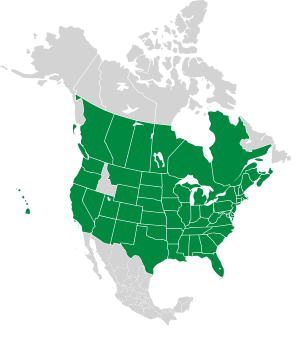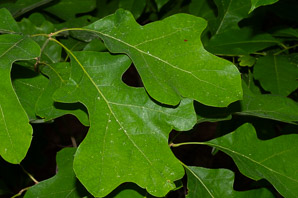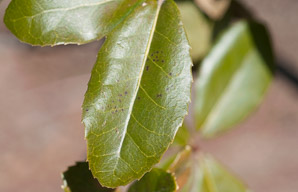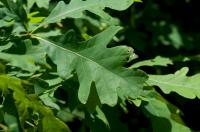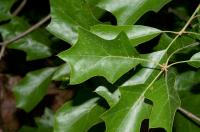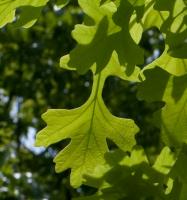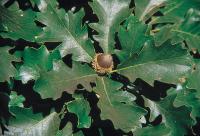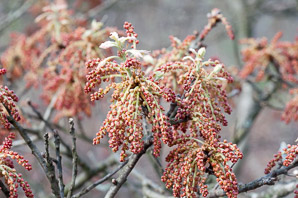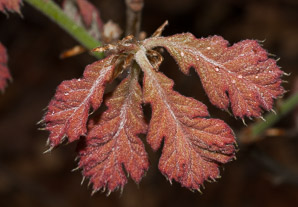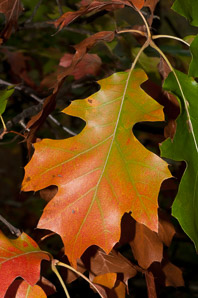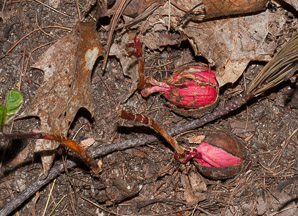
|
Quercus L. Oak
The genus Quercus, Latin for "oak," includes some 400 species worldwide, of which about 90 are found in North America. Identification: Most species of oaks can be differentiated by examining leaf shapes, but it isn't easy, since leaf shape in many oaks is extremely variable. Even a single tree can bear a wide range of leaf shapes. Try to assess "average" shape before making a determination based on leaf shape. If acorns are available, their shape is another important identifying characteristic. Many oaks have restricted ranges, another clue. Following are some species comparisons: |
(Quercus) · 5/29/2010 · Nashua River Rail Trail, Pepperell, Massachusetts · ≈ 11 × 7″ (27 × 18 cm) |
|||||||||||||||||||||||||
|
| ||||||||||||||||||||||||||
Quercus agrifolia |
Quercus alba |
Quercus bicolor |
||||||||||||||||||||||||
|---|---|---|---|---|---|---|---|---|---|---|---|---|---|---|---|---|---|---|---|---|---|---|---|---|---|---|
| Common Name |  |
 |
 |
|||||||||||||||||||||||
| Plant | These evergreens reach 20-82′ (6-25 m), with trunks up to 4′ (1.2 m) around. Trunks are short and the crowns are wide. | 65-80′ (19-24 m) tall, with a wide crown. | 65-80′ (19-24 m) tall. | |||||||||||||||||||||||
| Flowers | Male flowers are catkins 1¾-4″ (5-10 cm) long. Female flowers are ⅛″ (5 mm) long, in clusters of one to three, barely noticeable. | |||||||||||||||||||||||||
| Leaves |
Dark green, thick, glossy, oval in shape, alternating, edged with sharp fibers. They are ¾-2½″ (2-7 cm) × ⅜-1½″ (1-4 cm). |
Leaves 4-8″ (10-20 cm) long. Leaf tips are rounded. | Leaves are 4-8″ (10-20 cm) long, with many small rounded or slightly sharp lobes. | |||||||||||||||||||||||
| Stem | Bark is smooth and gray-brown when the tree is young, becoming darker and somewhat furrowed later. | |||||||||||||||||||||||||
| Fruit | Acorns are 1-1½″ (2.5-3.8 cm) long and ⅜-½″ (1-1.5 cm) wide, conical in shape. | Acorns ¾-1″ (1.9-2.5 cm) long. Bumpy cap covers about ¼ of the nut. | Acorns are about 1″ (2.5 cm) long, tan, with one or two on a long stalk. | |||||||||||||||||||||||
| Range/ Zones |
|
|
|
|||||||||||||||||||||||
| Habitats | Mixed evergreen forests, foothill woodlands, southern oak woodlands | |||||||||||||||||||||||||
| Type | Wild | Wild | Wild | |||||||||||||||||||||||
| Occurrence | Uncommon | Common | Common | |||||||||||||||||||||||
Quercus coccinea
Quercus ilicifolia
Quercus macrocarpa



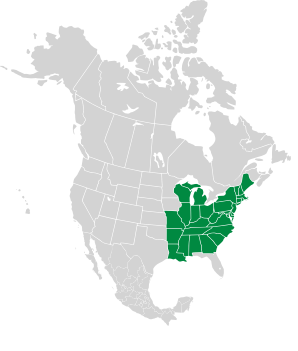

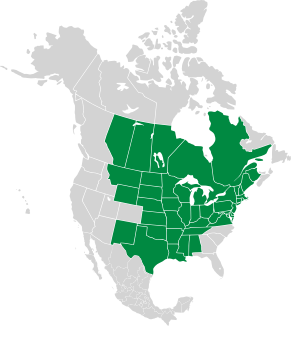
Quercus rubra
Quercus suber
Quercus velutina




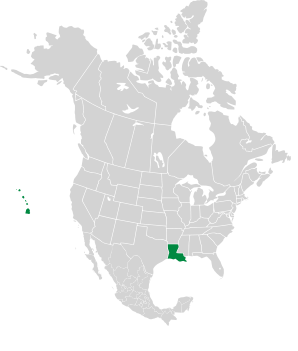
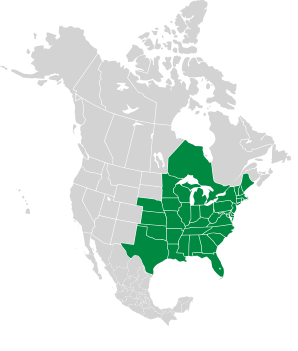
Online References:
Wikipedia (Quercus)
Wikipedia (Quercus)
References:
Sibley, David Allen, The Sibley Guide to Trees, Alfred A. Knopf, 2009, DirrHardyTS
(Quercus) · 5/29/2010 · Nashua River Rail Trail, Pepperell, Massachusetts · ≈ 14 × 9″ (35 × 23 cm) ![]() Species not yet identified
Species not yet identified 
Oak (Quercus) · 11/11/2008 · Acorn Trail, Great Brook State Park, Carlisle, Massachusetts · ≈ 2½ × 1½′ (84 × 56 cm) ![]() Species not yet identified
Species not yet identified 
(Quercus) · 4/23/2010 · Nashua Rail Trail, Ayer, Massachusetts · ≈ 6 × 4″ (15 × 10 cm) ![]() Species not yet identified
Species not yet identified 
Quercus description by Thomas H. Kent, last updated 16 Sep 2020.
© FloraFinder.org. All rights reserved.
(Quercus) · 4/27/2010 · Nashua River Rail Trail, Pepperell, Massachusetts · ≈ 4½ × 3″ (11 × 7.9 cm) ![]() Species not yet identified
Species not yet identified 
(Quercus) · 1/8/2012 · Groton Place and Sabine Woods, Groton, Massachusetts · ≈ 9 × 6″ (23 × 15 cm) ![]() Species not yet identified
Species not yet identified 
(Quercus) · 9/25/2010 · Nashua River Rail Trail, Groton Center, Groton, Massachusetts · ≈ 6 × 9″ (14 × 22 cm) ![]() Species not yet identified
Species not yet identified 
(Quercus) · 5/31/2010 · Mt. Lebanon St., Pepperell, Massachusetts · ≈ 9 × 6″ (23 × 15 cm) ![]() Species not yet identified
Species not yet identified 
(Quercus) · 9/29/2010 · Nashua River Rail Trail, Ayer, Massachusetts · ≈ 12 × 8″ (31 × 20 cm) ![]() Species not yet identified
Species not yet identified 
Range:
